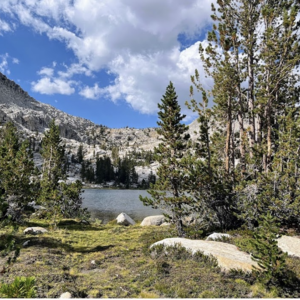You are here
Tettegouche State Park is the sixth largest state park in Minnesota, and it is made up of 9,346 acres containing six inland lakes, four waterfalls, and two iconic headlands and beaches along Lake Superior. The land that is now part of Tettegouche State Park was once home to the Alger-Smith Lumber Company in 1898. The company set up a logging camp along the shores of an inland lake, and after removing most of the Norway and white pine, the company sold the camp and surrounding area to the “Tettegouche Club” in 1910. The club was made up of businessmen from Duluth who used the area for fishing and retreat. Visitors today can stay in rentable cabins at Tettegouche Camp. Clement Quinn, a member of the Tettegouche Club, bought the others out in 1921 and protected the area until 1971, when he sold the area to the deLaittres family. The deLaittres continued preserving the land and began negotiations to make Tettegouche a state park. On June 29, 1979, Tettegouche was officially established as a state park.
Landscape
Tettegouche contains a unique combination of natural features including six inland lakes, 1 mile of shoreline along Lake Superior including the iconic Shovel Point and Palisade Head cliffs, four waterfalls, and rugged, semi-mountainous terrain. The High Falls of the Baptism River is the tallest waterfall completely within the state’s borders.
The Palisade Head and Shovel Point cliffs are popular spots for climbing because the cliffs are directly above Lake Superior.
The park provides access to the Superior Hiking Trail, 23 miles of hiking trails, and 15.5 miles of ski trails. A popular hike in this park follows along the Superior Hiking Trail to Bean Lake and Bear Lake.
Wildlife
More than 40 species of mammals are supported by the diverse plant communities in the park. Most commonly observed include snowshoe hare, red squirrel, beaver, and white-tailed deer. Less commonly seen include moose, black bear, red fox, and river otter. A variety of bird life can be viewed within the park;140 species have been identified within the park. Bird watchers can watch the hawk migration in the fall, and kinglets, spruce grouse and northern warblers in the summer. Peregrine falcons also nest in the park.
Amenities
There are several areas to camp within the park with options ranging from drive-in, cart-in, walk-in and kayak-in sites. The Tettegouche Camp, listed on the National Register of Historic Places, is located on Mic Mac Lake and offers four hike-in cabins. The visitor center is open year-round. Campgrounds in the park have flush toilets, showers, and firewood and ice can be purchased at the visitor center.
Logistics + Planning
Current Weather: Powered by Dark Sky
























Comments
Sign In and share them.